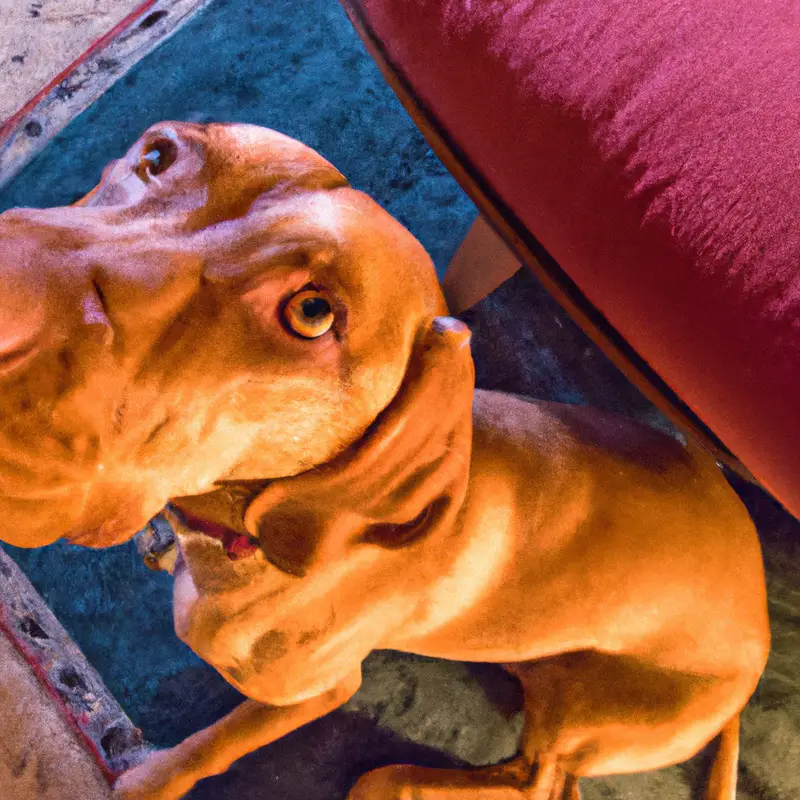How Do I Handle Vizsla’s Fear Or Anxiety-Related Behaviors?
Key Takeaways:
- You can help your Vizsla cope with fear or anxiety by creating a calm and predictable environment.
- Providing proper socialization and positive reinforcement training can mitigate fear-related behaviors in Vizslas.
- Veterinary consultation and potential use of medication can be effective in managing severe anxiety in Vizslas.
- Consistency and patience are crucial when addressing fear or anxiety-related behaviors in your Vizsla.
Does your Vizsla exhibit fear or anxiety-related behaviors that are causing you concern?
It’s not uncommon for these sensitive and energetic dogs to experience such emotions, but fortunately, there are effective strategies to help them overcome these challenges.
As an expert in canine behavior, I understand just how distressing it can be to see your beloved pet in a state of fear.
In this article, I will guide you through the steps to handle your Vizsla’s fear and anxiety-related behaviors.
From understanding the causes to creating a safe environment, implementing positive reinforcement techniques, seeking professional help if needed, and emphasizing consistency and patience, we’ll cover it all.
So, let’s get started on providing your Vizsla with the support and care it needs to overcome fear and anxiety and live a happy, stress-free life.
| Fear or Anxiety-Related Behaviors | Handling Techniques |
| 1. Excessive barking | • Help your Vizsla feel secure • Provide plenty of exercise and mental stimulation |
| 2. Separation anxiety | • Gradually desensitize your Vizsla to being alone • Use positive reinforcement training techniques |
| 3. Destructive behavior | • Provide appropriate chew toys and puzzles • Create a safe and secure environment |
| 4. Aggression or fear towards strangers | • Socialize your Vizsla from an early age • Use positive reinforcement to reward calm behaviors |
| 5. Thunderstorm or fireworks phobia | • Create a safe space where your Vizsla feels secure • Use counter-conditioning techniques to change their emotional response |
Understanding Vizsla’s Fear and Anxiety
What Causes Fear and Anxiety in Vizslas?
Fear and anxiety in Vizslas can be caused by a variety of factors. Some common triggers include genetics, lack of socialization, traumatic experiences, separation anxiety, and environmental changes.
Loud noises, unfamiliar people or animals, and changes in routine can also contribute to their fear and anxiety.
It’s important to identify the specific triggers and provide a secure and consistent environment for your Vizsla. Gradual exposure to fearful situations, positive reinforcement training, and seeking professional help if needed, can help your Vizsla manage their fear and anxiety.
Identifying Fear and Anxiety-related Behaviors in Vizslas
Identifying fear and anxiety-related behaviors in Vizslas can be crucial for their well-being.
Some signs to look out for include excessive barking, trembling or shaking, panting, pacing, and hiding.
Vizslas may also exhibit destructive behaviors, such as chewing furniture or excessive digging.
Other signs can include loss of appetite, aggression, and constantly seeking comfort or reassurance.
By being observant and recognizing these behaviors, you can better understand your Vizsla’s emotions and provide appropriate care and support.
Creating a Safe and Calm Environment
Provide a Secure Space for Your Vizsla
Your Vizsla needs a secure space where they can feel safe and calm.
Here are some tips to create a secure space for your dog:
- Designate a specific area in your home for your Vizsla. This can be a crate, a small room, or a cozy corner with their bed and toys.
- Make sure the space is private and quiet, away from loud noises or distractions.
- Consider using comforting items like blankets or clothing with your scent to provide familiarity and security.
- Provide access to fresh water and make sure the temperature is comfortable.
- Keep the space free from hazards and remove any objects that could potentially cause harm.
- Establish a routine and use positive reinforcement to help your Vizsla associate their secure space with positive experiences.
By providing a safe and secure space for your Vizsla, you can help them feel more relaxed and reduce their fear or anxiety-related behaviors.

Minimize Exposure to Triggering Stimuli
To minimize exposure to triggering stimuli for your Vizsla, it’s important to identify what specific triggers cause fear or anxiety in your dog. Once you know this, you can take steps to limit their exposure to those triggers as much as possible.
This might involve avoiding certain environments or situations that are known to trigger their anxiety, and gradually desensitizing them to those triggers through positive reinforcement and counterconditioning.
Additionally, providing a safe and quiet space for your Vizsla to retreat to when they feel stressed can also help minimize their exposure to triggering stimuli.

Positive Reinforcement Training Techniques
Counterconditioning and Desensitization
Counterconditioning and desensitization are two effective techniques for addressing fear or anxiety-related behaviors in Vizslas.
Counterconditioning involves pairing the trigger that causes fear or anxiety with something positive, such as treats or praise, to change the dog’s emotional response.
Desensitization involves gradually exposing the dog to the trigger at a low intensity, gradually increasing the intensity over time, while ensuring the dog remains calm and relaxed.
These techniques can help your Vizsla overcome their fear or anxiety and develop more positive associations with their triggers.
Teaching Relaxation and Calming Exercises
Teaching relaxation and calming exercises to your Vizsla can be beneficial in reducing fear or anxiety-related behaviors.
One effective exercise is deep breathing.
When your dog is calm, gently stroke their back while encouraging them to take slow, deep breaths.
Another exercise is progressive muscle relaxation.
Help your dog relax by gently massaging different muscle groups, starting from their head and working your way down to their tail.
Finally, you can use aromatherapy by diffusing calming scents, like lavender, to create a relaxing environment for your Vizsla.
Seeking Professional Help
When to Consider Consulting a Professional
If your Vizsla’s fear or anxiety-related behaviors are causing significant distress for both you and your dog, it may be time to consider consulting a professional. A professional can offer specialized knowledge and experience in dealing with these issues, providing you with guidance and support.
Some signs that it may be time to seek professional help include:
- The behaviors are escalating or becoming more frequent.
- Your efforts to alleviate the fear or anxiety are not making a noticeable difference.
- The behaviors are affecting your dog’s overall quality of life.
- The behaviors are putting your dog or others at risk of harm.
Remember, it’s important to find a professional who specializes in working with fearful or anxious dogs, as they will have the expertise needed to develop an effective treatment plan tailored to your Vizsla’s specific needs.

Finding a Qualified Dog Behaviorist or Trainer
Finding a qualified dog behaviorist or trainer is important when dealing with your Vizsla’s fear or anxiety-related behaviors. Look for someone who has experience and specialized knowledge in working with fearful or anxious dogs.
Ask for recommendations from your veterinarian, local animal shelters, or dog training clubs.
Do some research and read reviews to ensure the professional has a good reputation. Meet with the behaviorist or trainer beforehand to discuss their approach and methods to see if they align with your goals and values.
Trust and open communication are key in this relationship.
Consistency and Patience
Establishing Routines and Boundaries
Establishing routines and boundaries is key when handling a Vizsla’s fear or anxiety-related behaviors. Stick to a consistent schedule for feeding, exercise, and playtime to provide a sense of stability.
Establish boundaries by using clear and consistent rules in your household.
This will help your Vizsla feel secure and understand what is expected of them. Regular training sessions can also reinforce boundaries and build confidence.
Remember, patience and consistency are important in helping your Vizsla overcome fear or anxiety.
Practicing Regular Exercise and Mental Stimulation
Regular exercise and mental stimulation play a key role in managing your Vizsla’s fear or anxiety-related behaviors.
Engaging your dog in activities like daily walks, interactive play sessions, and obedience training can help alleviate their anxiety and provide a healthy outlet for their energy.
Additionally, giving them mental challenges through puzzle toys or scent training can keep their mind engaged and prevent boredom.
Remember, a tired and stimulated dog is a happier and calmer dog.
Frequently Asked Questions
Can medication help with Vizsla’s fear and anxiety?
Medication can be a helpful tool in managing a Vizsla’s fear and anxiety.
There are various medications available that can help reduce anxiety levels and promote a calmer state of mind.
Consult with a veterinarian who specializes in behavioral medicine to determine the best medication option for your Vizsla.
It’s important to note that medication should be used in conjunction with behavior modification techniques and a comprehensive treatment plan.
Regular communication with your veterinarian is key to ensure the medication is effective and safe for your dog.
How long does it take to see improvements in my Vizsla’s behavior?
Improvements in your Vizsla’s behavior can vary depending on the specific issue and your dog’s individual temperament.
Some dogs may show progress within a few weeks, while others may take several months.
Consistency and patience are key when addressing behavioral problems.
Positive reinforcement training, proper socialization, and seeking guidance from a professional dog trainer can help speed up the process.
Remember, every dog is different, so it’s important to be patient and adapt your approach as needed.
Final Verdict
Understanding and addressing your Vizsla’s fear and anxiety is crucial for their well-being. By identifying the causes and recognizing the behaviors associated with fear and anxiety, you can create a safe and calm environment.
Positive reinforcement training techniques such as counterconditioning and desensitization can help reshape your Vizsla’s response to triggering stimuli.
If necessary, seeking professional help from a qualified dog behaviorist or trainer is a valuable option. Consistency, patience, and establishing routines are key in helping your Vizsla overcome their fears.
Remember, it’s important to prioritize your Vizsla’s mental and emotional health, and with time, effort, and compassion, you can help them thrive.







